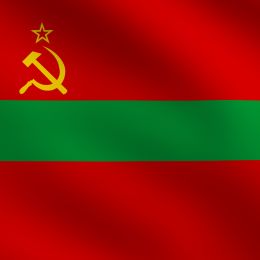Transnistria. I’d not heard of it until we planned our trip to Moldova. Residents here called the area, the Pridnestrovian Moldavian Republic (PMR). They have their own borders, flag, currency, and even a football team. But none of it is officially recognised by the UN or, anyone else, even long time ally, Russia. Commonly known in the English speaking world as Transnistria, that’s what I’ll use in this post. It’s thin sliver of land between Moldova and Ukraine and if you’re already in Moldova, Transnistria is easy to get to, both on public transport and on a tour. Here’s my guide to visiting Transnistria from Chisinau.
THIS POST MAY CONTAIN COMPENSATED AND AFFILIATE LINKS MORE INFORMATION IN OUR DISCLAIMER
Visiting Transnistria is one of the easiest day trips you can take from Chisinau. You can also stay overnight if you have the time — I’ll cover the details on that shortly, but first some preparatory information. There’s a definite trill in crossing the border to a place that doesn’t officially exist, and yeah, I can’t deny that seeing the signs for Odessa so close – made me feel a little nervous. Then there was the UK FCDO’s clear advice not to travel here.
PRACTICAL TRAVEL TIPS
- 🛡️ Get Travel Insurance: Civitatis includes medical expenses, repatriation, theft, luggage delays. No deductibles or upfront payments. Get a quote here.
- 💰 Read about the Currency in Moldova and ATM fees.
- 🔌 Check out Moldova’s plug, socket & power situation.
- 📶 Internet, maps and data on the go. eSims for Moldova
It’s definitely quite strange. When you arrive, it feels like stepping back in time. Although I don’t quite know why I say that as I never visited ex-Soviet countries when they were, well Soviet countries, perhaps its just what I’ve seen on TV and in movies. But here the Soviet-era statues are still in public places, the government buildings have got hammers and sickles, and in a truly oligarchist move worthy of today’s age, Sheriff, the local mega-company, stamps its name on everything from supermarkets to the football stadium.
EASIEST WAY TO VISIT
Take a Small Group Tour to Transnistria
Visit Bender Fortress and the highlights of Bender, then Tiraspol, and see the Soviet Era monuments, buildings and evidence of the 1990’s conflicts. Eat at a retro Soviet restaurant and have a local guide drive you and explain the history and nuances of visiting Transnistria.
What is Transnistria?
Transnistria, or the Pridnestrovian Moldavian Republic (PMR) as it calls itself, is a strip of land sandwiched between Moldova and Ukraine. You have to cross a border, there’s no passport stamp, but you get a separate entry card that you have to retain for your trip, and then suddenly you’re somewhere that feels like a different country — but officially, at least according to the rest of the world, you’re still in Moldova.
The territory that we know as Transnistria broke away after the collapse of the Soviet Union in the early 1990s, and since then it’s been operating with a sort of independence. It has its own government, its own military, its own flag, and even its own currency, the Transnistrian ruble. There are border guards, police officers, and government offices, but none of it is officially recognised by the UN or by Moldova itself.
The other places in the world that acknowledge Transnistria as “real.”are other other breakaway regions, like Abkhazia and South Ossetia.
Not even Russia officially recognises Transnistria’s independence, but it does maintain special relations with the territory — political, military, cultural, and of course, economic. This support is one of the main reasons Transnistria has managed to function in this unusual limbo for more than three decades.
Where is Transnistria?
Transnistria stretches for about 400 kilometers along the eastern bank of the Dniester River, wedged between Moldova to the west and Ukraine to the east. The name “Pridnestrovian” Moldavian Republic means “beyond the Dniester River in Russian, whereas in Moldova the territory is called Stinga Nistrului.
Tiraspol is its capital and Bender (sometimes Bendery) as its second city. There is a population of around half a million people that call Transnistria home.
The Moldovan capital of Chisinau is just 70 kilometers (about 43 miles) from Tiraspol, making the trip by marshrutka or car an easy two hours or so. That proximity is what makes Transnistria such a straightforward day trip option. Want the easy way? Take this trip.
Why Visit Transnistria?
Curiosity. Because we’d never been. And because it was there. Those were our reasons.
We hadn’t even heard of it until we started planning an independent trip to Moldova, but then it niggled and niggled at me.
And so we came and saw for ourselves.
Why Shouldn’t You Visit Transnistria?
Transnistria isn’t for everyone. Part of the appeal is exactly that it’s an oddity, but that comes with drawbacks too.
First, the obvious one: politics. Transnistria isn’t recognised as a country. It’s a breakaway territory with its own government, army, and flag, but officially you’re still in Moldova. Its identity leans strongly towards Russia, and the symbols of that alignment are everywhere. With what’s happening in the world you might feel uncomfortable with that. I did, but it didn’t stop me visiting.
Then there’s the practical side. You’ll need cash, unless you visit with a tour guide, who can help you. The currency, Transnistrian rubles can’t be exchanged outside the area. ATMs are few and probably won’t work with your card. Internet and mobile service can be patchy. English isn’t widely spoken, and outside Tiraspol there’s not a lot set up for visitors.
If you’re short on time in Moldova, there are easier trips — wineries, Orheiul Vechi, or the monasteries in the countryside.
Most importantly, you need to consider official travel advice. The UK’s Foreign, Commonwealth & Development Office (FCDO) is blunt:
“FCDO advises against all travel to Transnistria. There is widespread military activity in Ukraine, including close to some Moldovan borders. Transnistria is outside the control of the Moldovan government.”
Other countries may have similar warnings. And here’s the key issue: if you travel somewhere your government advises against, your travel insurance may be invalidated.
We spoke with our guide (who was fabulous), consulted local news, and decided to go. We’d already made the mistake of not visiting Odessa a few years before the Ukraine–Russia war, and we skipped the Three Gorges in China before they dammed it. We didn’t want any more regrets. For us, the curiosity outweighed those reasons, and we trusted our guide to get us to safety if there were issues.
Things to See in Transnistria
If you’re coming for the day on the bus, then you’ll need to get up early to make the most of it. And limit yourself to just a few of these things to see. Here’s the highlights. You’ll need to pick and choose which to visit, but here’s the top things to see.
Bender (Bendery)
Memorial to Grigory Potemkin
Opposite the supermarket is the Bender Memorial and a statue to Grigory Potemkin. Born in 1739, he died in 1791, near Iasi. He was a Russian statesman and army officer, also lover to Catherine the Great! He was responsible for adding Crimea to the Russian Empire, he planned the colonization of Ukraine, but Russia ran out of money. He was, for about 17 years, the most powerful man in the Russian Empire.
The anecdote “Potemkin Village” to mean “provide an external façade to make people think its better than the reality comes from him. He built a “fake portable village” for Catherine the Great’s visit to Crimea in 1787. The portable village was assembled, Catherine passed it, it was disassembled and then rebuilt further down the route and so on.
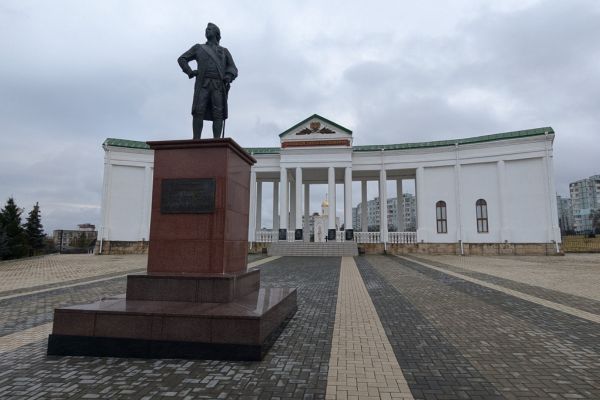
After you pass Potemkin’s memorial you’ll see the Triumphal Arch of Bender. Designed by Zauchevic, it was built in 1840 to commemorate the Russian victory over the Ottamans in the war of 1828-9.
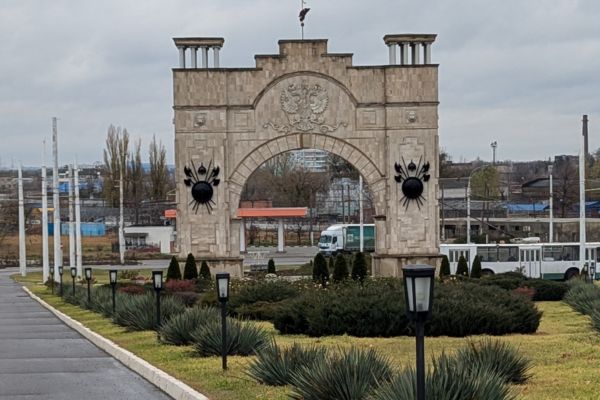
Bender Fortress
Built in the 16th century by the Ottomans, the fortress has changed hands countless times and today stands as the main attraction in Bender. You can walk the walls, see small exhibitions, and get a sense of the city’s layered history. The museum inside is worth a visit. Entrance is 50 Transnistrian rubles, you can pay with foreign currency. Don’t miss the ghost story of the White Lady’s Wall.
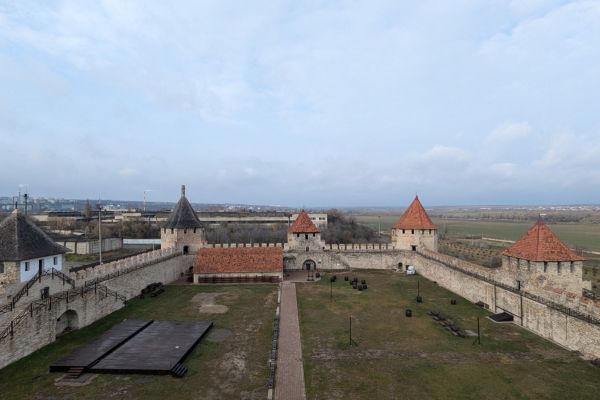
If you’re here during cold weather (as we were), it is positively freezing walking around the walls!
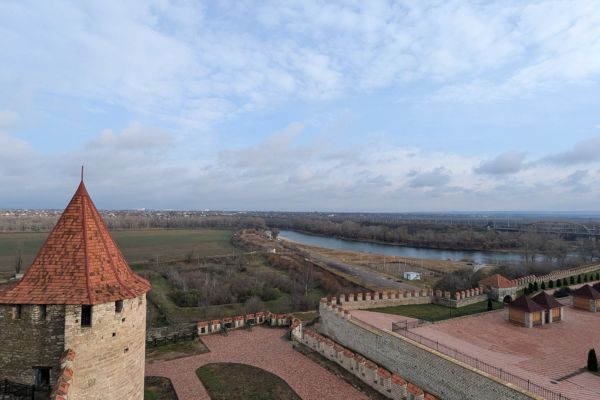
While you’re in Bender, there’s a walking trail around the town that’s worth your time. It takes in the Fortress, several churches and museums. There’s a photo of the trail below.
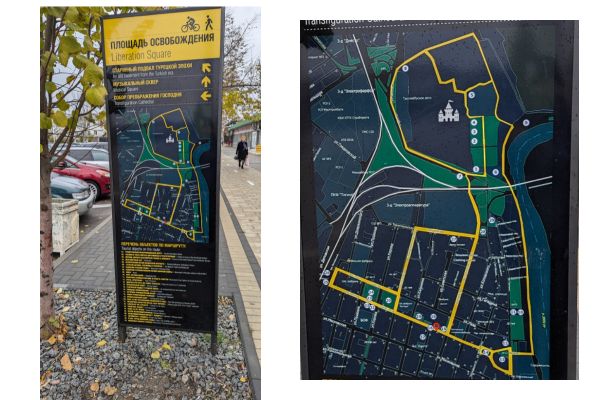
Do visit the Gorky Cinema, while the building is impressive from the outside, its absolutely lovely on the inside too.
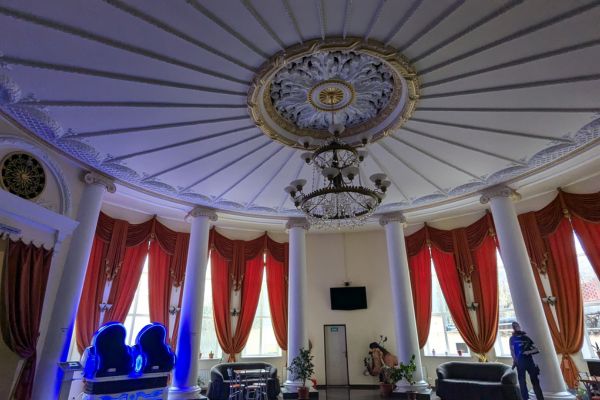
Make a stop at Bender’s historic train station, another loveld building, with some great Soviet era monuments outside (as well as the ubiquitous train too). The train line was once of stragetic importance – supporting the Russian army against the Turks in the Russian/Romanian/Turkish War of 1877-8. More than 11,000 people were involved in the construction It took just 100 days to complete the 304 kilometer (189 mile) line.
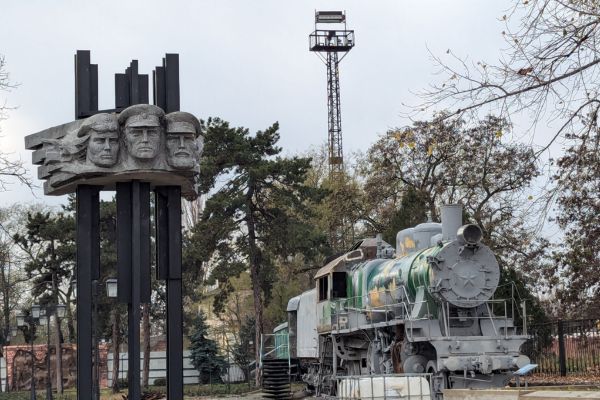
As you drive, or walk, around Bender you’ll see evidence of the 1991-92 conflict still visible on buildings, in much the same way that you can still see evidence of fighting in Sarajevo, Bosnia.
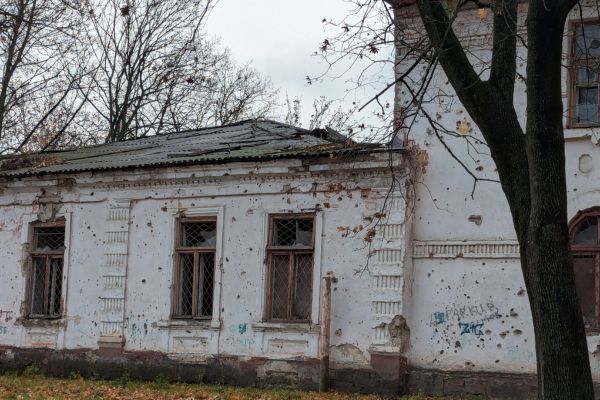
The Alexander Nevsky Church is also worth a photo stop. It was consecrate in 1833 with the Emperor Nicholas I in attendance. The Emperor Alexander II visited and prayed here as did Tsar Nicholas II along with his family.
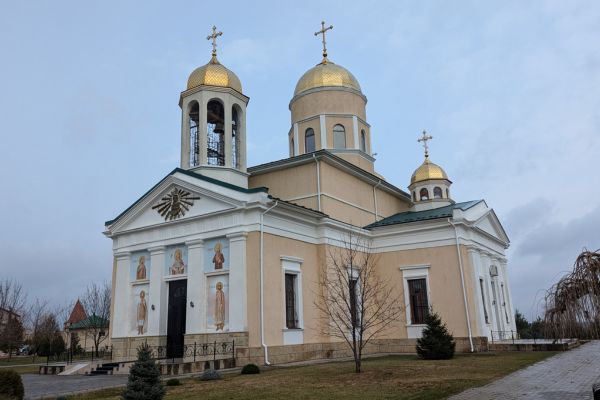
During the Soviet era, the chirch was confiscated and a military club operated from it. It fell into disrepair, and was refurbished and reopened in 2008.
Tiraspol Highlights
Most of what you’ll want to see in Tiraspol can be navigated to from the main drag – 25th October. The naming of the main street here refers to the 1917 October Revolution, when Vladimir Lenin led a coup d’etat to overthrow the government and begin the world’s first socialist state.
The Lenin Statue & House of the Soviets
Tiraspol’s central square is dominated by a large Lenin statue standing in front of “the House of Soviets” – its what the Transnistrians call their Parliament building, it’s worth stopping for a photo.
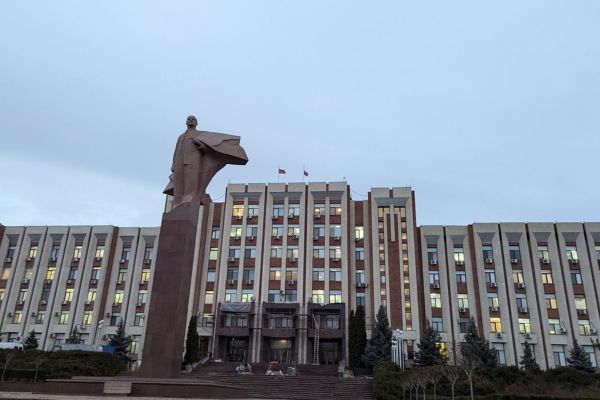
The Suvorov Monument
The bronze statue of Suvorov on a horse is of the Russian general who founded Tiraspol in 1792. It’s one of the most famous symbols of Tiraspol and Transnistria, its on bank notes and stamps.
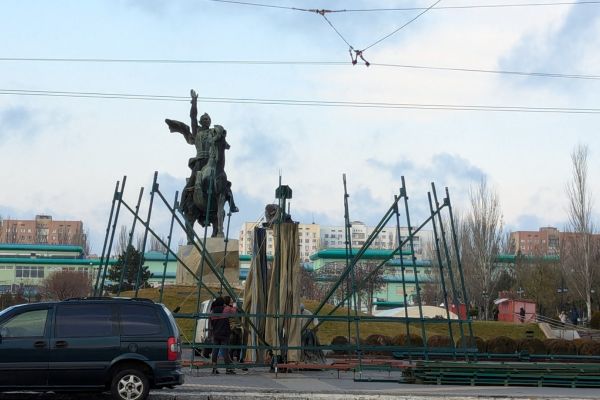
The Sheriff Stadium & Supermarkets
The Sheriff corporation runs almost everything in Transnistria — supermarkets, petrol stations, even the football team. The stadium is modern and impressive, even just from the outside. And visiting a Sheriff supermarket is an experience in itself, its something we do in every country we visit. The caviar section is unlike anything I’ve ever seen in a supermarket.
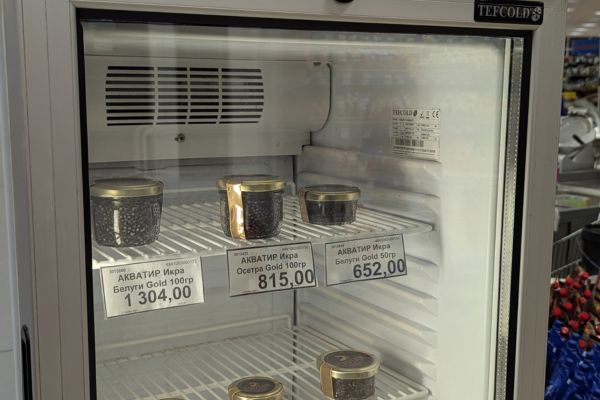
You’ll find Russian chocolate here alongside Lavazza coffee. Everything you need really. There’s also, in the supermarket in Bender, a large selection of linens. I bought a tea towel. Not that I needed one, its just pretty. Our guide paid for it in Transnistrian rubles and I gave her Moldovan lei in return.
Memorial of Glory aka the Transnistrian War Memorial
This area is dedicated to those who died in World War II and the 1992 Transnistrian conflict. There’s an eternal flame, a T-34 tank on a stack of rocks, which is probably the most photographed item for people visiting and military memorials.
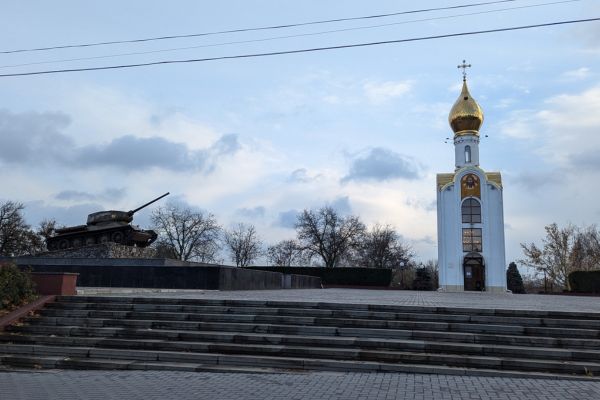
Tiraspol National Museum aka Museum of Local History
A small museum covering local history, Soviet memorabilia, and the story of Transnistria, obviously from their point of view. It’s one of the few places where you’ll find exhibits in English.
Kvint Distillery
Transnistria’s pride and joy, Kvint produces brandy and cognac that regularly wins international awards. If you want to visit, then tours and tastings need to be arranged in advance.
Vodka Bottle Museum
Again run by Kvint, this museum details the region’s vodka production and you’ll need to arrange a visit in advance. Their site is here.
Aquatir Sturgeon Farm
One of Europe’s largest sturgeon farms, producing caviar. A visit to the farm/factory and tastings are possible, but you need to book several days in advance, and bring a Russian speaker. Arrange a visit by calling.
Have Lunch at the Back in the USSR Restaurant
If you’re in Tiraspol around lunchtime, there’s one spot you shouldn’t miss — Back in the USSR.
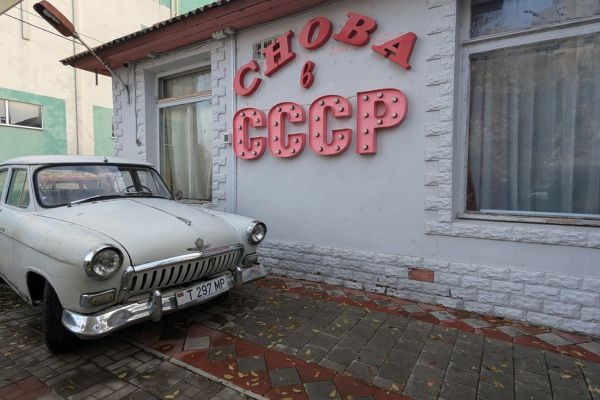
It’s a Soviet-themed restaurant cum museum. It almost feels as though you’re walking into your Russian Grandma’s house from decades ago. And the displays are great for sticking your nose into.
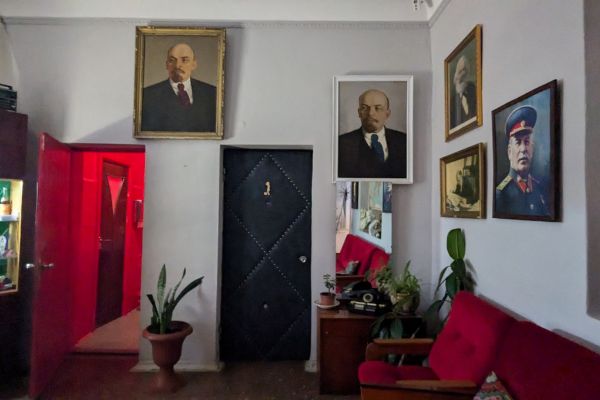
The team here are welcoming, and the menu was great with bowls of borscht, served with a shot of vodka, grilled shashlik skewers, and pelmeni. The local beer was good and cold. There’s more on the food and drink of Moldova here.
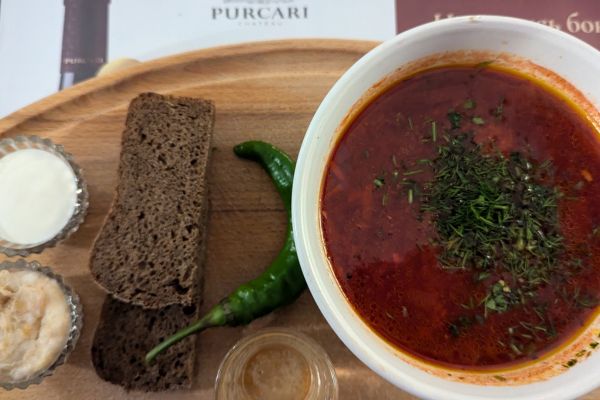
Noul Neamt Monastery
It’s just a short drive from Tiraspol to the Orthodox monastery whichwas originally founded in the 19th century. It closed during the Soviet era, and was rebuilt later.
Day Trip vs Overnight Stay to Transnistria
There are considerations for how long you spend in Transnistria, if you have any Russian language skills, then you’ll have a better time of it, but if you don’t, then you’re probably best sticking to a day trip.
Visiting Transnistria on a Day Trip
It is easy to visit Transnistria as a straightforward day trip from Chisinau. With Tiraspol just over 70 kilometers (43 miles) away, you can leave in the morning and be back in your hotel in Chisinau by the same evening. I think a day gives you enough time to see Tiraspol’s highlights — Lenin statues, Suvorov Monument, the Sheriff supermarket, Victory Park — and have plenty of time for a stop at Bender Fortress.
For a day trip, the 10-hour entry permit issued at the border is perfectly suited. You don’t need to worry about registration, and the marshrutka schedule or a guided tour makes it simple to plan. If your time in Moldova is limited, a day trip lets you experience the atmosphere and tick off the big sights without too much hassle.
For more ideas of day trips from Chisinau check out my recommendations here.
Staying Overnight in Transnistria
If you have more time, you can see Tiraspol without rushing, enjoy an evening meal in a Soviet-style restaurant, and even sample some nightlife. The next day, you can head to Noul Neamt Monastery, explore more of Bender, or visit the Aquatir Sturgeon Farm.
If you’re staying overnight, then you need to register. If you’re staying in a hotel they’ll usually take care of it for you, but confirm this when you check in.
How to Get to Transnistria
Transnistria is only accessible overland from Moldova. There are no airports in the territory, and the border with Ukraine is currently closed and not recommended. That makes Chisinau the easiest and most straightforward base for a visit. It’s just over 70 kilometers (about 43 miles) to Tiraspol, which takes roughly two hours depending on traffic and border checks.
Go to Transnistria on a Tour from Chisinau
The simplest option is to join a guided day tour from Chisinau. Tours usually include transport, a guide who speaks English, and help with the border formalities. They run regularly and cover the main sights in Tiraspol, and usually have a stop in Bender and a winery on the way back. This is the most stress-free way to visit.
We worked with a local guide, just her and us in her car. It didn’t feel like a tour at all — more like travelling with a trusted friend. We stopped in Bender, explored Tiraspol, had lunch at Back in the USSR, and washed it down with vodka shots and local beer. On the way back we stopped at a winery, and the best part? We were dropped off directly at the airport, saving us a trip back into Chisinau. Superb. I couldn’t recommend it more.
Go to Transnistria on Public Transport from Chisinau
Marshrutkas (minibuses) are the cheap way to get to Transnistria. They leave from Chisinau’s Central Bus Station, which sits right by the central market. The destination signs say “Tiraspol” or “Bender.”
Tickets cost 59 lei #. Buy them at the ticket booth or directly from the driver. They depart every 30 minutes or so, usually from platforms 1–4. The first bus leaves around 07:00 and the last scheduled departure is around 18:00 — though I wouldn’t rely on catching the very last one. The journey takes about two hours, and buses arrive at the central bus station in Tiraspol.
The route passes through Bender, so you can get off there or continue to Tiraspol. If you go straight to Tiraspol and later want to visit Bender, you can take bus number 19 back. It takes 20 minutes on the bus from Tiraspol to the stop for Bender (it’s the first one after the river) and from there, its an easy walk to the fortress, which is the main attraction in Bender.
From Chisinau you’ll get to the border after about an hour. Everyone has to get off the bus to go through passport control before you carry on. On the return, it’s usually even easier — you may not need to leave the bus, as passports are often collected and handed back after a few minutes. If you’re out of Transnistrian rubles, you might be able to pay your return fare in Moldovan lei, but expect to be charged more (around 75 lei). The last bus back is roughly 19:00.
By Taxi or Private Car
You can take a taxi or arrange a private driver in Chisinau. The journey is faster than the bus, usually about 90 minutes and you can stop along the way. It’s also more convenient if you’re travelling as a group. However, it’s significantly more expensive than public transport and usually requires some negotiation or advance booking through a local contact or guide.
As of 2025, it is not possible to take the train from Chisinau to Tiraspol. This is because of the Ukraine-Russia war.
Visas and Entry Requirements for Transnistria
One of the most common questions about visiting Transnistria is whether you need a visa. The short answer is no — there is no separate visa process. If you can legally enter Moldova, you can also cross into Transnistria.
What you do need is your passport. At the border you’ll be given a small slip of paper, an “entry card.” It’s printed with your name, passport details, and the duration of your permitted stay. Most visitors are given 10 hours, which is fine for a day trip, but you can request a longer period if you’re planning to stay overnight. Keep it safe — it’s your proof of entry and you’ll need to hand it back when you leave. Lose it, and you could face fines or a long headache with the local authorities.
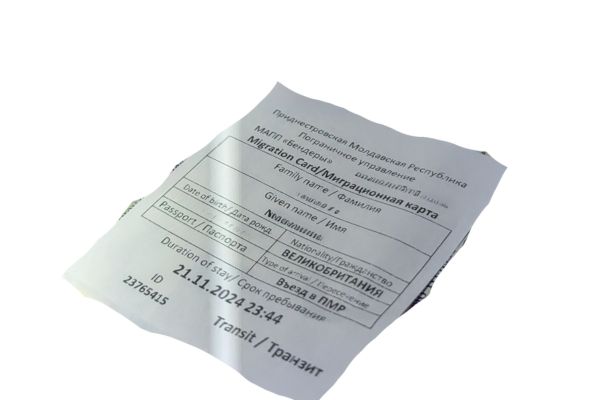
Crossing the Border into Transnistria
The main crossing point from Chisinau to Transnistria is on the road between Bender and Tiraspol. Whether you’re on a tour, in a marshrutka, or in a private car, the process is much the same. About an hour after leaving Chisinau, you’ll reach the checkpoint.
We were in a private car and did not need to exit the car either on the way there or the way back. We just handed over our passports and received them and the entry slips back through the window.
On the return journey, things are usually even simpler. If you’re on a bus, the driver will usually collect everyone’s passports, hand them to the border guards, and return them stamped a few minutes later. Occasionally you may be asked to step off again, but it’s typically quicker than the entry process.
The Currency of Transnistria
One of the quirks of visiting Transnistria is their own currency: the Transnistrian ruble. It’s different to the currency of Moldovan, which you can read about here. You won’t find it anywhere else in the world, and you can’t exchange it outside the territory. For collectors, the notes themselves are a bit of a souvenir — some are made from brightly coloured plastic rather than paper, and the coins come in unusual shapes.
When you arrive, you’ll need to change some money if you want to pay for food, transport, or museum tickets. The easiest place is at official exchange kiosks inside the Sheriff supermarkets, or banks in Tiraspol, which will exchange Moldovan lei, euros, US dollars, or Russian rubles into Transnistrian rubles.
As we were travelling by private car, we stopped at the Sheriff Supermarket in Bender, which has a currency exchange desk. You should stop at one of these supermarkets anyway, they’ve got everything.
Don’t expect to use your credit and debit cards. Sheriff supermarkets and a handful of larger places may take them, but don’t count on it. Most cafés, buses, and small attractions expect cash only. As a rough guide, things in Transnistria are noticeably more expensive than in Chisinau.
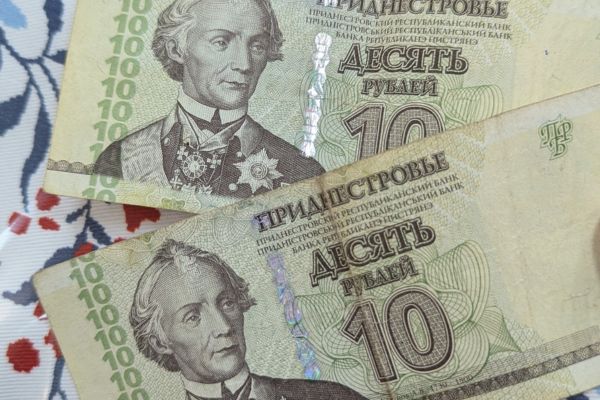
Entrance fees to sights like the Bender Fortress are 50 rubles per person (cheaper for Transnistrian residents). It’s sometimes possible at the fortress to pay in foreign currency, but there’s no published exchange rate, so expect it to be arbitrary. For reference, the official exchange rates are posted on the Pridnestrovian Republican Bank website.
You may find that marshrutka drivers on the way back to Chisinau accept Moldovan lei if you’ve run out of rubles, but they’ll usually charge you more (around 75 lei). It’s better to plan ahead and keep a small reserve of rubles until you’re safely back over the border.
Is Transnistria Safe?
Transnistria is generally safe to visit. Walking around Tiraspol feels calm and unthreatening. I never once felt unsafe while we were there.
The Moldovan Government publishes a “current situation” and keeps it up to date on their website – that’s here. However, you can still book tours with trusted sites like Get Your Guide and Viator. Always ask locally.
Russian is the main language here, and there’s very little English.
The UK and other governments advise against travel here because of Transnistria’s proximity to Ukraine and its unrecognised status. While that didn’t stop us from going, it’s something you need to weigh carefully, especially if your travel insurance might be invalidated.
History & Background to Transnistria
The roots of Transnistria’s unusual status go back to the breakup of the Soviet Union. On 3 September 1990 the area now known as Transnistria declared its independence from Moldova.
Before breaking away, this region was essentially the economic crown jewel of the Moldavian Soviet Socialist Republic (MSSR). It was the industrial engine, powering much of the country and producing around 40% of Moldova’s GDP. The political elite hailed from here, and Soviet troops were a permanent presence. Bessarabia, however, the Romanian-speaking heart of Moldova, was far more rural, relying heavily on agriculture and wine production. By the time the USSR was collapsing, life in Transnistria looked relatively comfortable and its standard of living was roughly double that of the rest of Moldova.
Then, when Moldova declared independence from the USSR, on 27 August 1991, tensions flared with the mainly Russian-speaking population on the eastern side of the Dniester River. Those communities feared closer ties with Romania and wanted to keep strong links with Moscow.
In 1992 the dispute turned violent. A short but intense war broke out between Moldovan forces and the Transnistrian separatists, backed by parts of the Russian 14th Army. A ceasefire was agreed in July of that year, leaving Transnistria outside the control of the Moldovan government but not officially recognised as a country. Russian peacekeepers are still stationed along the river today. You’ll see them when you visit.
Since then, Transnistria has run its own government and elections, issues its own passports, and maintains its own army, but it remains unrecognised by the international community. Economically and politically it leans heavily on Russia, which despite not recognizing it officially, still provides financial support, subsidised gas, and cultural ties that keep the independent existence alive.
MOLDOVA TRAVEL RESOURCES
AIRPORT TRANSFERS
24/7 pickup & drop off. Trusted, local English speaking drivers. Prebook & prepay online with cards.
Book a Transfer
HOTELS AND APARTMENTS
See choices here
Rooms with a view? Budget rooms? Need a washing machine? The best choice of hotels & apartments.
TOURS & ATTRACTIONS
Most excursion choices, small group tours, skip-line tickets, free cancellation and top local guides.
Top options here.
CAR RENTAL OPTIONS
Choose cars here
Best choice of vehicles, automatics, large or small cars, child seats. Book early for more options.
The Name: Transnistria or Pridnestrovie?
You’ll hear two names for the same place. Internationally, it’s called Transnistria, a Latin-based term that simply means “beyond the Dniester.” Locally, though, you’ll see and hear Pridnestrovie, which is the Russian word for the same idea.
Official documents you get at the border — like your entry slip — will say Pridnestrovie. Road signs and government offices use it too. But guidebooks, news articles, and most blogs stick with Transnistria. They’re interchangeable, so you’ll see both.
Final Thoughts: Visiting Transnistria from Chisinau
Transnistria is one of those places that’s hard to describe until you’ve been. It’s close to Chisinau, yet it feels like stepping into another world. You cross a border that doesn’t officially exist, you use money that’s not valid anywhere else, and you walk past Soviet symbols everywhere. It’s not for everyone, but we enjoyed the day and felt safe during our visit. Definitely one of the more memorable trips we’ve taken!
ASocialNomad is a participant in the Amazon Services LLC Associates Program, an affiliate advertising program designed to provide a means for sites to earn advertising fees by advertising and linking to amazon.com, amazon.co.uk, and amazon.ca. Amazon and the Amazon logo are trademarks of Amazon.com, Inc. or its affiliates. As an Amazon Associate, I earn from qualifying purchases.

